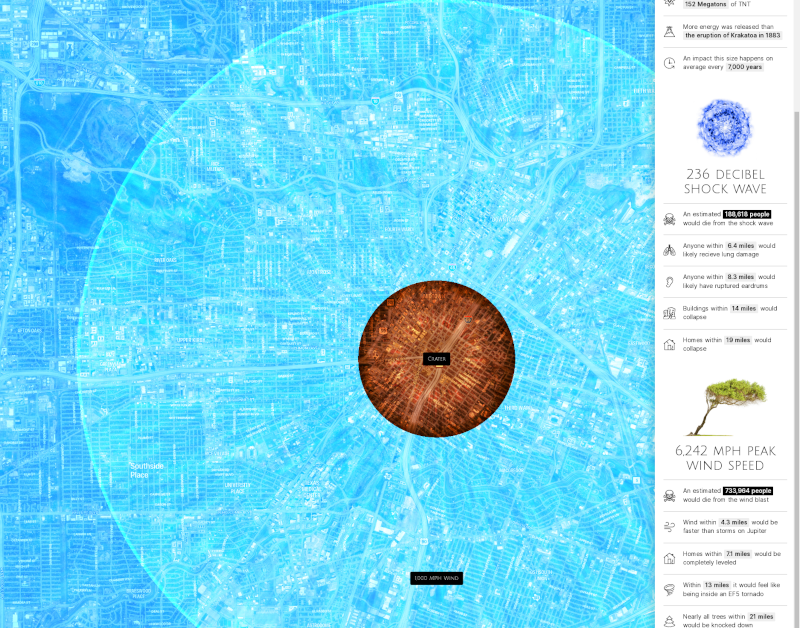There was a comedian in the 1980s who always said he grew up in a tough neighborhood. He claimed they played cops and robbers with real cops. They played gin rummy with real gin. Well, maybe if he knew about [Neal Agarwal]’s asteroid launcher simulation website, he would have said they played asteroids with real asteroids.
If you ever wondered what would happen if a 1,500-foot stone or iron asteroid hit your hometown going at 38,000 mph, now you can find out. Apparently, I live far enough in the suburbs that even a 1 mile-wide iron asteroid hitting the center of Houston wouldn’t put a crater under my house. The 17-mile-wide and 2,608-foot-deep crater would release the equivalent of 399 Gigatons of TNT, but it wouldn’t reach me.
The 29-mile-wide fireball would be a different story. Oh, and the 244 dB shockwave would almost certainly reach me. So if the clothes catching on fire resulting in second- and third-degree burns didn’t get me, perhaps the shockwave would. The simulation says that zone will have 99% fatalities, and even further out, people will get severe lung damage. Eardrums burst even further away. Homes would collapse almost to the Mexican border.
The 1,000-mile-per-hour wind might present problems, too. While we are well-situated for hurricanes in this area, that’s about five times more wind than even a big hurricane generates. And we are not well prepared for earthquakes, much less the magnitude 70 quake that would occur.
Pretty bleak. On the plus side, a strike like that happens about once every 2.6 million years. If you try it yourself, be sure to scroll down the right panel to see the graphical representation of the different effects.
Maybe NASA is on to something when they tell us they want to learn to deflect asteroids. Even private foundations are getting into the business of finding them.
















Excellent!
Here’s the equivalent with nuclear weapons:
https://nuclearsecrecy.com/nukemap/
Fun. It would be cool if it could factor in terrain features such as mountains and canyons into account.
Sites like TVFool might give you some idea if there’s TV transmitter near where you want to guesstimate impact at. However that site has been in zombie mode for a couple of years now, nobody at the helm.
How many asteroid near collisions has Earth had over the last 25 years that came so close that major media outlets suppressed reports of these “events” until the rock had passed us? Time Mag’s Eco-idiot of the Year Musk said several years ago that for ~ $60 million (?) he could launch and maintain an army of asteroid deflecting robots orbiting the Earth. At least he’s right that the technology is hardly complex and maintenance costs-even if only shared by a few of the leading tech advanced nations-would amount to a pittance. Yeah, right, but where is it? Another pipe dream from the great genius. NASA and the rest of these procrastinating clowns better damn straight serious and right NOW about risks of this kind, magnitude and likelihood. And unless there’s another such close encounter beforehand, Apophis is due to blow Earth a kiss from just 13K miles away in 2029. Tick…..Tick………Tick…..
Did you miss the DART test? We can do stuff if anything gets close enough, as long as we see it in time.
Maybe you could have everyone pile their mattresses downtown to make the landing softer /s
Neat tool, really wish it wasn’t using apple maps.
Then museum at Meteor Crater in Arizona (https://meteorcrater.com/) had a simulation that let you vary mass, speed, and angle of incidence. My young son LOVED it. After playing with it for a while he managed to destroy the planet. This is still one of his fondest memories.
This showed up on FARK a few days ago. Mar-a-lago was a popular target.
A “magnitude 70 earthquake” would entail many orders of magnitude more energy than a supernova explosion.
It would be many orders of magnitude more energy than EVERY STAR IN THE OBSERVABLE UNIVERSE GOING SUPERNOVA SIMULTANEOUSLY.
If this tool really claims that as an earthquake intensity estimate, I don’t have much faith in the rest of its output.
I wonder if that was a typo, I just tested it with an asteroid the size of dimorphos and it gave me 6.2 magnitude.
Uhh, maybe it’s meant to read as a 7.0? I managed to get a magnitude 9.6 with a gold asteroid 1mi diameter, with 5 degrees and max speed.